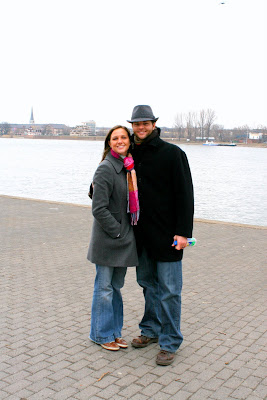Jamie and Sam on the bank of the Rhine River in Mainz
The Romanesque Dom in the center of the Altstadt (old town) is a 12th century replacement of the first one that burnt down in 1066.
(Side note: It's funny how now when I see a structure that dates from the 18th or 19th century I think, "Oh, that's not that old," whereas I used to think our house back in the U.S. was really old because it was built in 1935. Now it takes being from the 11th or 12th century for me to be like, "Wow. That's old." I guess that is what touring Germany does to you after awhile.)
One weird thing about this Dom is that it has merchant buildings connected to it which make it look a bit bigger than it is.
Dom and connected buildings below
Jamie, Penelope and I in front of the market by the Dom
inside the Dom
interesting sculpture inside the Dom--looks like crucificion and ascenscion tied into one

Dom family portrait
Penelope portrait

Mainz was pounded by bombers during WWII, so most of the city's original structures were destroyed. Fortunately, several of the historic buildings surrounding the Dom were either spared or rebuilt. Here are a couple charming ones in the Marktplatz.

Our favorite sight in Mainz was St. Stephen's church. It was founded in 990 and sits atop the highest hill in the city. During WWII the church was badly damaged, including its stained glass windows.

Mainz was pounded by bombers during WWII, so most of the city's original structures were destroyed. Fortunately, several of the historic buildings surrounding the Dom were either spared or rebuilt. Here are a couple charming ones in the Marktplatz.

Our favorite sight in Mainz was St. Stephen's church. It was founded in 990 and sits atop the highest hill in the city. During WWII the church was badly damaged, including its stained glass windows.
That was when the famous artist Marc Chagall stepped in. Chagall was actually Jewish and had to flee his home in France during the Nazi occupation. He decided to design the stained-glass windows at St. Stephan's as a symbol of Jewish-German reconciliation. The pictures in the windows focus on scenes from the Old Testament, demonstrating the commonalities between the Jewish and Christian traditions.
The second we stepped inside the church, we were blown away by how striking his work is. It was like being inside of a Chagall painting.
It was difficult to capture the images in the windows on camera, but if you are a fan of Chagall, it is well worth the trip to see these.
windows that line the aisles















No comments:
Post a Comment